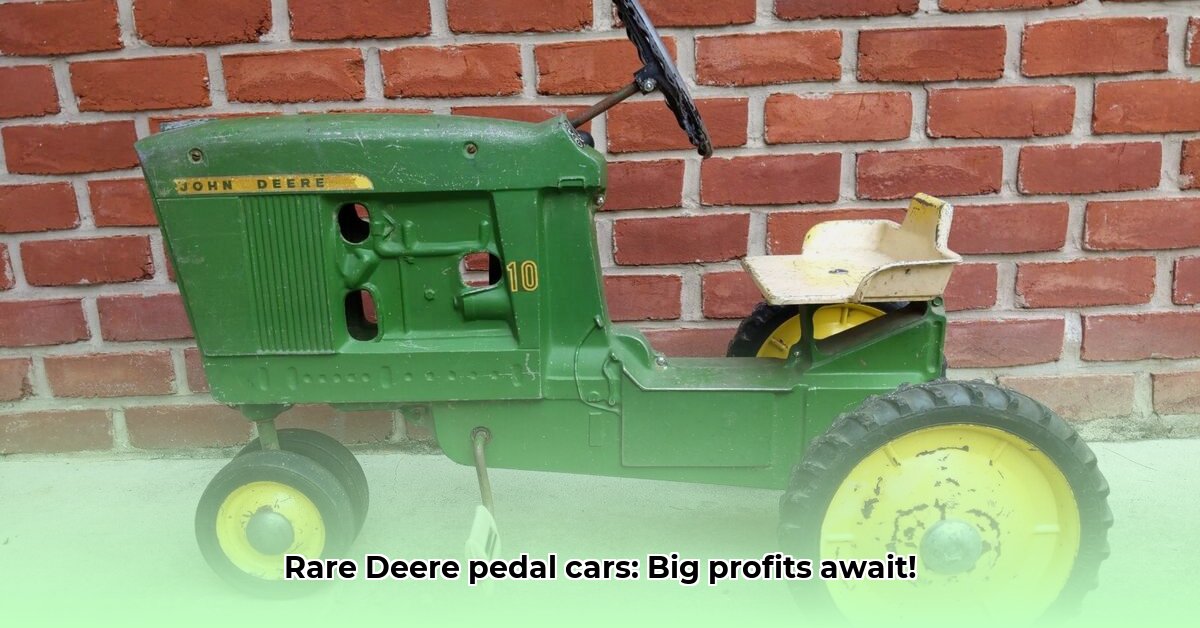
Investing in unique collectibles can be both rewarding and profitable. John Deere tractor pedal cars represent a fascinating niche market with significant potential for growth. This guide will equip you with the knowledge to identify valuable models, assess their worth, and make informed investment decisions. For more in-depth information on these tractors, check out this helpful resource: John Deere Pedal Tractors.
Identifying Valuable Models: Spotting a Collector's Gem
The value of a John Deere pedal tractor hinges on its rarity and condition. Pre-1970 models are particularly desirable due to their simpler manufacturing processes and unique details. But what specifically should you be looking for?
- Original Paint: A tractor with its original, unrestored paint is a significant find. Even minor touch-ups can dramatically reduce value. Think of it as a time capsule from a bygone era.
- Complete Accessories: The presence of all original parts, from steering wheels and seats to decals and other accessories, significantly enhances collectibility and value.
- Overall Condition: The state of preservation directly impacts value. Minor wear is expected, but extensive damage will severely lower a tractor's worth.
- Rarity: Certain models and color combinations are rarer than others – research is key to identifying these hidden gems. Online forums and collector communities are invaluable resources.
Finding one of these treasures can be an exciting hunt. Imagine the thrill of discovering a pristine example tucked away in a dusty antique shop or emerging victorious from a tense online auction!
Pricing and Market Trends: Understanding Market Value
Precise pricing for John Deere pedal tractors is challenging due to limited market data. However, several discernible trends indicate strong investment potential.
Generally, tractors produced before 1970 command significantly higher prices than later models. Condition is paramount; pristine, unrestored examples fetch premium prices. Proper restoration can increase value substantially, but only if executed correctly using authentic or high-quality reproduction parts. Conversely, poor restoration will diminish value.
Here's a generalized pricing overview (USD), acknowledging significant variability based on individual condition, rarity and specific model:
| Year Range | Typical Price Range (USD) | Notes |
|---|---|---|
| Pre-1960 | $500 - $5000+ | Prices heavily influenced by condition and model |
| 1960-1970 | $300 - $2000+ | Wide price range depending on condition and rarity |
| Post-1970 | $100 - $500+ | More common, resulting in lower values |
Remember, these are estimates only. Actual selling prices can vary considerably. Careful research, including reviewing completed listings on online auction sites, will aid in more accurate valuation.
Finding and Assessing John Deere Pedal Tractors: A Buyer's Guide
Your search for a valuable John Deere pedal tractor can extend across various avenues:
- Online Marketplaces (eBay, etc.): These offer a broad selection, but thorough inspection of photos and descriptions is vital to avoid disappointments.
- Antique Shops and Flea Markets: These often hold hidden gems, requiring patience and keen observation.
- Auctions and Estate Sales: These can unearth exceptional finds, but require prior research on the seller's reputation.
Before committing to a purchase, a meticulous inspection is crucial. Follow these steps:
- Visual Examination: Carefully scrutinize for paint damage, rust, and missing components.
- Functional Test: Check pedal and wheel operation for smoothness and functionality.
- Authenticity Verification: Research the specific model to ensure authenticity; compare to images of known original tractors. Attention to detail is paramount.
- Detailed Documentation: Photograph the tractor extensively before and after any cleaning – crucial for future sales and insurance.
Restoration and Maintenance: Protecting Your Investment
Proper restoration can significantly enhance a pedal tractor's value. However, it requires expertise and the use of authentic or high-quality reproduction parts. Poorly executed restoration will negatively affect value.
Key Restoration Considerations:
- Authenticity of Parts: Prioritize original parts or high-quality reproductions to maintain the tractor's historical integrity.
- Professional Expertise: For complex repairs, consider consulting experienced restoration specialists—their skills protect the tractor's future value.
Investing in John Deere Tractor Pedal Cars: A Strategic Approach
Investing in these iconic toys offers potential for significant returns. However, careful planning and research are essential:
- Set a Budget: Define your investment limits before you begin searching.
- Targeted Search: Focus your search on specific, desirable models based on your research.
- Negotiation: Skillful negotiation will secure the best possible price.
- Long-Term Strategy: Understand that significant returns often require patience.
Remember, the market for these collectibles is driven by passion and nostalgia. Combine your knowledge with a well-defined investment strategy to maximize returns.
How to Restore Pre-1970 John Deere Pedal Cars to Increase Their Value
Restoring a pre-1970 John Deere pedal tractor is not merely repair; it's a process of historical preservation and value enhancement. This requires attention to detail, patience and expertise.
Sourcing Parts and Resources:
Finding replacement parts may require some detective work. Websites specializing in toy restoration, online forums, and even local antique shops can be valuable sources. Dakota Toy Parts (https://www.dakotatoys.com/) is a reputable starting point. Remember that using authentic or high-quality reproduction parts is crucial for maintaining and enhancing value.
Key Takeaways:
- Pre-1970 John Deere pedal tractors represent a valuable niche collecting market.
- Original paint, accessories, and complete sets are essential for high value.
- Thorough inspection and authentication are vital before purchase.
- Skilled restoration significantly increases a tractor's worth.
- Patience, research, and a strategic approach are key to successful investing.